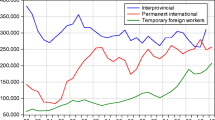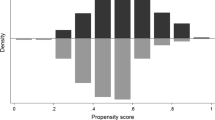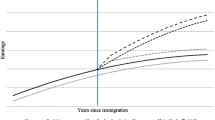Abstract
This paper estimates how local conditions at the time of immigration influence later outcomes for refugee immigrants to Norway, exploiting the quasi-experimental nature of the Norwegian system for settlement for “quota” or resettlement refugees. A unique administrative dataset with assigned settlement municipalities is used to identify the causal effect of initial location characteristics. Being placed in a labor market where other non-OECD immigrants do well increases own annual labor earnings up to 6 years after immigration. Extended models suggest that this effect is not driven by individual scarring effects: when controlling for the contemporaneous employment rate in the assigned region, effects of initial conditions disappear. Rather, the effects appear to be due to persistence in local labor market conditions combined with limited geographical mobility in response to adverse labor market conditions.




Similar content being viewed by others
Notes
The only exception is the “introduction benefit” described above, which is only available to program participants (refugee immigrants including former asylum seekers and their families).
7 individuals are registered with a country of origin that was a member of OECD before 1990 (excluding Turkey). Countries of origin for the excluded individuals are France, The Netherlands, Great Britain, Switzerland and Germany. These observations likely reflect an error in recorded country of origin or refugee status, and are excluded from the sample.
Australia, Belgium, Canada, Denmark, Finland, France Greece, Ireland, Iceland, Italy, Japan, Luxembourg, The Netherlands, New Zealand, Portugal, Spain, The UK, Switzerland, Sweden, Turkey, Germany, USA, Austria.
The 12 regions in the sample are North Africa, Middle Africa, East Africa, Western Africa, South-East Asia, South Asia, Central Asia, West Asia, East Asia, The Balkans, Europe (Other) and Latin America. These regions are roughly based on the UN Statistics Division’s M 49 standard for area codes.
“Immediate movers” are retained in the sample, with local characteristics defined using the assigned municipality. The decision of whether or not to comply with assignment program could be motivated in part by characteristics of assigned municipality, in a way which varies across individuals according to unobserved characteristics. For instance, highly motivated workers could be more likely to move in response to being assigned to a depressed region. Excluding these individuals from estimations would lead to a selected sample and biased estimates.
As an additional robustness test, I have run a series of t tests for differences in means between persons placed in regions with low employment (at or below sample median, calculated by year of arrival) and those placed in regions with high immigrant employment rates. Results are shown in the “Appendix”. This approach finds somewhat more evidence of selection on observables, primarily by country background, but also to a lesser extent demographics (marital status and gender). For the variables arguably most closely related to unobserved components of the earnings potential, indicators of high school and college degrees, as well as age, there appears to be no differences between the two groups.
Source: OECD harmonized unemployment rates.
References
Åslund O (2005) Now and forever? initial and subsequent location choices of immigrants. Reg Sci Urban Econ 35(2):141–165
Åslund O, Rooth D (2007) Do when and where matter? Initial labour market conditions and immigrant earnings. Econ J 117(518):422–448
Bhuller M (2009) Inndeling av norge i arbeidsmarkedsregioner. Statistisk Sentralbyrå (SSB). Notater 24
Blom S (2011) Holdninger til innvandrere og innvandring 2011. Statistisk Sentralbyrå (SSB). Rapporter 41
Chiswick B, Cohen Y, Zach T (1997) The labor market status of immigrants: effects of the unemployment rate at arrival and duration of residence. Industrial and labor relations review, pp. 289–303
Kahn L (2010) The long-term labor market consequences of graduating from college in a bad economy. Labour Econ 17(2):303–316
Kavli HC, Svensen E (2001) Overføringsflyktninger - uttak og integrering. Fafo-notat 8
Longva P, Raaum O (2002) Unemployment and earnings assimilation of immigrants. Labour 16(3):469–489
Nekby L, Pettersson-Lidbom P (2012) Revisiting the relationship between ethnic diversity and preferences for redistribution. Research Papers in Economics, Stockholm University, Department of Economics, 9:1–34
Olsen B (2014) Flyktninger og arbeidsmarkedet, 4. kvartal 2012. Statistisk Sentralbyrå (SSB). Rapporter 06
Oreopoulos P, von Wachter T, Heisz A (2012) The short-and long-term career effects of graduating in a recession. Am Econ J Appl Econ 4(1):1–29
Raaum O, Røed K (2006) Do business cycle conditions at the time of labor market entry affect future employment prospects? Rev Econ Stat 88(2):193–210
Ruhm C (1991) Are workers permanently scarred by job displacements? Am Econ Rev 81(1):319–324
Acknowledgments
I wish to thank Olof Åslund, Barbara Petrongolo, Knut Røed, Edwin Leuven, Pål Schøne, Andreas Kotsadam and seminar participants in Århus (ESPE), Torino (EALE) and Bonn (IZA Annual Migration Meeting), as well as two anonymous referees for valuable comments. Data made available by Statistics Norway have been essential.
Author information
Authors and Affiliations
Corresponding author
Additional information
This research is part of the projects “Social Insurance and Labor Market Inclusion in Norway” (Grant 202513) and “Convergence or Segregation” (Grant 217264), financed by the Norwegian Research Council.
Appendix
Appendix
1.1 Sorting on observables: t tests
As an additional check for sorting on observables, I have run a series of t tests for differences in means between those placed in regions with low employment (at or below sample median, calculated by year of arrival) and those placed in regions with high immigrant employment rates (above the sample median). Results from these t tests are shown in Table 4. This exercise reveals some differences. The most pronounced differences are in terms of geographical background, i.e., region of origin. Refugee immigrants from East Africa are over-represented in low-employment regions, while persons from Southeast Asia are over-represented in high-employment regions. The tests also find differences in terms of demographics: being female and married is associated with a lower probability of being placed in high-employment regions. For the variables arguably most closely related to unobserved components of the earnings potential, indicators of high school and college degrees, as well as age, there appears to be no differences between the two groups.
1.2 Full estimation results
Table 5 contains estimates from the models of Sect. 3, showing estimated coefficients not included in Table 3.
Rights and permissions
About this article
Cite this article
Godøy, A. Local labor markets and earnings of refugee immigrants. Empir Econ 52, 31–58 (2017). https://doi.org/10.1007/s00181-016-1067-7
Received:
Accepted:
Published:
Issue Date:
DOI: https://doi.org/10.1007/s00181-016-1067-7




